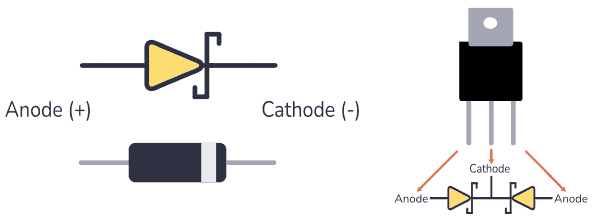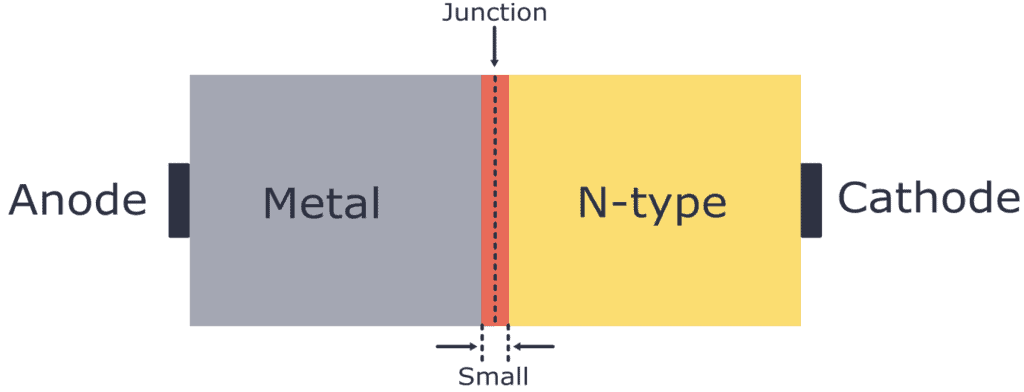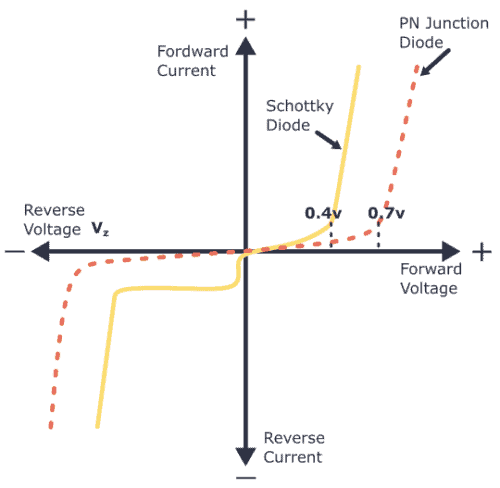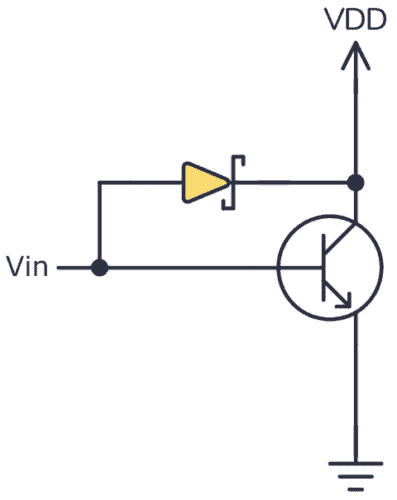In this guide, you will discover what a Schottky diode is and how it can be used in electronic circuits.
Did you know that Schottky diodes, unlike other diodes, are formed by the junction of a semiconductor material with a piece of metal? That’s gives it some special properties that can come in handy.

What Is a Schottky Diode?
Diodes are components that normally only let current flow in one direction. Like a regular diode, the Schottky diode allows current to flow in the forward direction when enough forward voltage is applied.

However, while a regular PN junction diode is made by connecting p-type and n-type semiconductors, the Schottky uses metals like gold, tungsten, platinum, or aluminum instead of the p-type semiconductors.

This difference in construction gives it some unique properties that make it very useful for some specific applications. The Schottky diode has a relatively small voltage drop, usually between 0.15 to 0.45 V. This low forward voltage enables it to switch on and off much faster than traditional PN junction diodes.
How to Use Schottky Diodes
The Schottky diode works like any other PN junction diode, but faster. Current can flow through it only when it’s forward-biased. To make this happen, you must connect the anode to the most positive side and the cathode to the most negative side. Take a look at this example:

You can see above that the diode is forward-biased. That means the LED will light up because current can flow through it. When you use a Schottky diode like this, it’s like a fast switch that is closed and lets the current flow through the circuit.
Now let’s rotate the diode:

When the Schottky is reverse biased (cathode on the most positive side and anode on the most negative side) current can’t flow, so it acts like an open switch and the LED won’t turn on.
Schottky Diode vs PN Junction Diode
Schottky diodes are often compared to the PN junction diode. It’s because they behave very similarly. To understand the differences between them, take a look at their V-I characteristic curves:

Consider that the curves above correspond to semiconductors made of silicon. You can see that the Schottky diode behaves a lot like a standard PN junction diode, except for one thing: the knee voltage – which is when it starts conducting – is much lower at around 0.4 V.
Thanks to its lower forward voltage drop, the Schottky diode can carry more current than a typical PN junction diode. The formula for power is power = volts x current (P = V*I). This means that a smaller forward voltage drop at a given current will result in less power dissipation than the PN junction diode. In plain English, the Schottky diode doesn’t get as hot as a regular diode.
Also, since Schottky diodes don’t have a p-type semiconductor, they have a low recovery time. This allows faster switching between on and off states.
Summary of Differences Between Schottky Diode and PN Junction Diode
| Schottky diode | PN junction diode |
|---|---|
| Formed by the junction of a piece of metal and an n-type semiconductor material | Formed by the junction of n-type and p-type semiconductor materials |
| Lower voltage drop | Higher voltage drop |
| Faster state change (on/off) | Slower state change (on/off) |
Applications of Schottky Diode
Some common applications of the Schottky diode include:
- Reverse current protection
- Solar cell applications
- Discharge protection
- Voltage clamping
- Switched-mode power supplies
- Logic gates circuits
- Radio frequency mixer and detector diodes
Schottky-clamped Transistor
A Schottky-clamped transistor is a type of BJT transistor. It has a Schottky diode connected across its base-collector junction and it is designed to switch on and off very quickly.

The Schottky diode in the transistor allows for faster switching by reducing the time it takes for the transistor to turn on and off. This is useful in applications where you need to switch things on and off rapidly. It also to helps reduce the amount of energy lost when the transistor is on, making the transistor more efficient. This means it can do its job while using less power.
Another advantage of a Schottky-clamped transistor is that it can handle voltage spikes and sudden changes in voltage without getting damaged. This makes it more reliable and durable in circuits where there might be fluctuations in voltage.
Schottky-clamped transistors are commonly used when you need fast switching and efficient operation, such as in power supplies, amplifiers, and digital circuits. They are especially good for applications involving radio signals and high frequencies.
Copyright Build Electronic Circuits
No comments:
Post a Comment